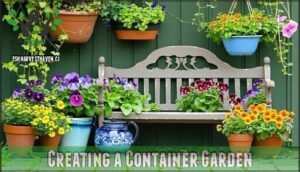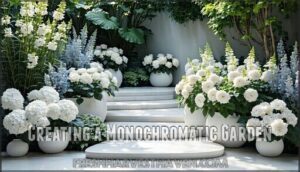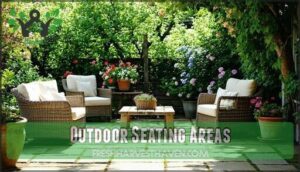This site is supported by our readers. We may earn a commission, at no cost to you, if you purchase through links.

Start with mass plantings of early bulbs like tulips and daffodils as focal points, then add flowering shrubs and emerging perennials around them.
Plan your color palette carefully—soft pastels create gentle spring awakening vibes, while bold combinations celebrate the season’s energy.
Don’t forget the structural bones: pathways, seating areas, and trellises provide year-round framework.
Smart timing means planting early-blooming trees as anchors, then filling spaces with annuals that’ll keep your garden stunning through late spring, creating layers that unfold like nature’s own symphony with a careful color palette and smart timing.
Table Of Contents
- Key Takeaways
- Spring Garden Planning
- Garden Design Ideas
- Spring Color Palette
- Garden Maintenance Tips
- Outdoor Seating Areas
- Frequently Asked Questions (FAQs)
- How to design a spring garden?
- What is the best way to layout your garden?
- What should I put on my garden in the spring?
- What is the easiest plant to grow in spring?
- What makes a great Spring Garden?
- Can you make a DIY spring garden decoration?
- What to do in the garden this spring?
- What is a good Spring Garden?
- How do you prepare a garden for a new season?
- How do I prepare my garden for spring?
- Conclusion
Key Takeaways
- You’ll create stunning visual impact by planting spring bulbs like tulips and daffodils in masses of 25-50 rather than scattering them individually throughout your garden beds.
- You’ll achieve continuous color from early spring through summer by layering different bloom times – start with early bulbs, add mid-season perennials, then finish with late-spring annuals.
- You’ll establish a strong foundation by installing structural elements like pathways, seating areas, and trellises first, then building your plantings around these permanent features.
- You’ll maximize your garden’s appeal by choosing either soft pastels for a gentle awakening feel or bold color combinations that celebrate spring’s energy, but stick to one cohesive palette throughout.
Spring Garden Planning
Planning your spring garden requires careful thought about layout and plant selection.
Start by sketching your space and choosing flowers that bloom at different times for continuous color throughout the season.
Creating a Garden Layout
Before tackling your spring garden design plans, map out your space like a puzzle waiting for perfect pieces.
Start by sketching your yard’s dimensions and noting sunlight patterns throughout the day.
Create an effective garden layout with these essentials:
- Focal Points – Position eye-catching elements like sculptures or specimen plants
- Garden Pathways – Design clear routes that connect different garden zones
- Plant Placement – Group plants by height and growing requirements
Smart space optimization means balancing visual appeal with practical access for watering and maintenance tasks.
Smart garden design puts beauty where you can reach it and function where you need it most.
Choosing Spring Flowers and Bulbs
Now that you’ve mapped your garden layout, selecting the right spring flowers and bulbs becomes your next adventure.
The secret lies in mixing perennials, annuals, and spring blooming bulbs for continuous color from early spring through summer.
Consider your Bulb Planting Time carefully.
Plant bulbs 6-8 weeks before your first frost date at depths 2-3 times their height.
Space them 4-6 inches apart to prevent overcrowding and disease.
For a wide selection, consider browsing various spring bulbs online.
Focus on Fragrant Spring Blooms like hyacinths and Native Spring Wildflowers to create sensory-rich displays that attract pollinators while establishing your spring garden design foundation.
Selecting Garden Furniture and Decor
With your flowers mapped out, you’ll want furniture that won’t buckle under spring’s unpredictable weather. Weather resistance tops the priority list – teak weathers beautifully while aluminum stays rust-free forever.
Furniture materials shape your garden’s personality:
- Teak and cedar deliver 75-year durability with natural pest resistance
- Recycled plastic offers eco-friendly, low-maintenance options growing 15% annually
- Wrought iron provides classic elegance while aluminum gives lightweight versatility
Space optimization matters more than you’d think. Foldable pieces work magic in smaller yards – 52% of urban gardeners swear by multi-functional designs.
Budget considerations don’t mean sacrificing style. Mix vintage finds with new pieces for character without breaking the bank. Your outdoor seating should invite lingering, not just looking pretty.
When designing your garden, consider the importance of small space gardens to maximize your yard’s potential.
Preparing Garden Soil and Beds
Once you’ve selected your furniture and decor, soil testing becomes your next priority. Test your garden soil to identify pH levels and nutrient gaps.
Mix compost into beds to improve structure and fertility. Bed preparation includes clearing debris during garden cleanup and adding drainage materials for heavy clay soil type.
Create defined edges for professional-looking garden beds. Apply fertilizer based on test results, then finish with mulch selection for moisture retention and weed control.
For accurate results, consider using reliable soil testing kits to assess your soil’s condition.
Garden Design Ideas
Spring garden design transforms outdoor spaces through strategic plant placement and thoughtful layout choices.
You’ll create stunning visual impact by combining mass plantings with creative containers and eye-catching features that attract both people and pollinators, utilizing strategic plant placement to enhance the overall effect.
Planting en Masse for Impact
Why settle for scattered blooms when mass planting creates stunning floral displays?
This garden design trend transforms ordinary spaces into vibrant landscapes through strategic blooming clusters. Plant identical species together for maximum garden impact.
Here are three mass planting strategies for spring garden design ideas:
- Tulip sweeps – Plant 25-50 bulbs of one variety for dramatic spring flowers garden displays
- Layered bulb combinations – Place daffodils above muscari for contrasting blooming clusters
- Groundcover drifts – Use low-growing perennials in large groups for textural garden impact
Creating a Container Garden
Container gardens transform any space into a blooming paradise. You’ll love the flexibility they offer.
Container gardens offer instant beauty anywhere you need it most.
Start with smart Container Choices that match your space. Large ceramic pots work great for patios. Window boxes bring charm to boring walls. Hanging baskets add vertical interest without taking floor space.
Your Soil Mix makes or breaks success. Combine quality potting soil with compost for nutrients. Skip garden dirt – it’s too heavy and doesn’t drain well.
Planter Arrangements create visual impact. Group containers in odd numbers. Mix heights and textures for depth. Place tall planters in back and shorter ones in front.
Garden Styles vary from rustic to modern. Galvanized buckets give vintage vibes. Sleek ceramic pots suit contemporary looks.
Blooming Combinations steal the show. Pair upright flowers with trailing varieties. Mix colors that complement each other. Try yellow pansies with purple violas for spring magic.
These container garden ideas work anywhere. Small spaces benefit most from vertical small garden design solutions. When selecting containers, consider the container pot options to find the perfect fit for your garden.
Incorporating Water Features and Lighting
Strategic water features and garden illumination transform ordinary yards into evening sanctuaries.
Install pond lighting around small fountains or water falls to create mesmerizing reflections. Solar-powered garden illumination offers eco-friendly pathway safety while string lights add magic to trees.
Pool landscaping benefits from underwater LED systems. Consider fountain designs that match your maintenance schedule and budget.
These spring garden design ideas blend garden water features with outdoor lighting for stunning garden landscaping ideas that make your spring garden decor ideas shine after dark with mesmerizing reflections and eco-friendly solutions.
Designing a Pollinator-Friendly Garden
When designing your pollinator garden, native flowers create the foundation for thriving eco systems.
Choose pollinator plants that bloom from spring through fall. Here’s your action plan:
- Plant native flowers in clusters of 7-9 for maximum impact
- Install bee hotels facing southeast for morning sun
- Leave bare soil patches for ground-nesting bees
- Add shallow water sources with landing stones
- Skip pesticides to protect garden wildlife
This pollinator-friendly approach transforms your spring garden design into a buzzing paradise that supports local pollinators year-round. By incorporating native plant species into your garden, you can create a more diverse and resilient ecosystem.
Spring Color Palette
Color transforms your spring garden from ordinary to extraordinary. Start with a color strategy that matches your style and watch your outdoor space come alive with personality.
Choosing Pastel Colors and Vibrant Flowers
Your spring garden color choices set the mood for the entire growing season.
Pastel hues create calming spaces while vibrant blooms add energy and drama. Early spring flowers like tulips and daffodils deliver soft colors that gradually give way to bolder summer displays.
Consider these spring garden design ideas for your color schemes:
- Lavender patches that release fragrance while attracting beneficial pollinators to your yard
- Cheerful yellow daffodils that push through late snow like tiny suns announcing spring’s arrival
- Bold purple tulips that create striking focal points against fresh green foliage backdrops
- Crisp white cherry blossoms that bring peaceful moments to busy garden corners
- Electric blue muscari that mirror clear April skies after invigorating spring rains
Mix petal choices strategically for continuous color from early March through late May.
Incorporating Decorative Elements and Textures
Beyond color, Garden Textures create depth in your spring garden design ideas.
Mix feathery ferns with bold hostas for stunning contrast.
Decorative Stones around pathways add visual weight while Natural Elements like weathered wood bring authenticity.
| Texture Type | Best Materials | Design Impact |
|---|---|---|
| Rough | Stone, bark, gravel | Grounds vibrant colors |
| Smooth | Metal, glass, ceramic | Reflects light beautifully |
| Soft | Outdoor Fabrics, moss | Invites touch and comfort |
Select garden art that matches your personality.
Woven baskets make charming planters while vintage crockery adds character.
Garden Textiles like outdoor rugs define spaces perfectly.
Create vertical drama with trailing vines against smooth walls.
These outdoor living spaces become conversation starters when textures dance together.
Your Color Schemes pop when supported by thoughtful texture choices that make garden decor feel intentional rather than scattered.
Selecting Colors for Garden Furniture and Accents
Color schemes for garden furniture and accents can make or break your outdoor living spaces.
Choose weather-resistant pieces that complement your blooms. Bright color pops against neutral backgrounds create instant visual impact.
Blues promote calm feelings while yellows energize your space. Match furniture paint to your garden hues for cohesive design.
Consider current decor trends but prioritize colors that reflect your style and enhance your spring garden design. Effective container gardening tips can also elevate your overall garden aesthetic.
Creating a Monochromatic Garden
A monochromatic garden transforms your yard using tonal variations of one color family. This approach creates sophisticated color harmony while maintaining visual interest through garden texture contrasts.
Choose your single hue carefully – whites work beautifully with silver foliage plants and cream blooms.
Here’s how to nail monochromatic schemes:
- Layer different textures like feathery grasses with broad-leafed hostas
- Mix matte and glossy finishes through varied plant surfaces
- Add structural elements like matching planters or pathway stones
These spring garden design trends prove that restraint creates the most striking spring garden design ideas.
Garden Maintenance Tips
You’ll need to maintain your garden regularly to keep it looking its best throughout the spring season.
Proper maintenance tasks like cleaning up debris and protecting plants will guarantee your garden thrives and stays healthy all year long, which is essential for complete garden care.
Digging, Dividing, and Transplanting Perennials
During dormant season, you’ll want to tackle Perennial Care with confidence.
Plant Division becomes essential when clumps spread beyond their boundaries. Use sharp Garden Tools to slice through root systems cleanly.
Soil Prep matters – mix compost into planting holes before Transplant Tips come into play. Water thoroughly after moving perennial plants.
This spring garden maintenance prevents overcrowding while expanding your collection. Planting en masse with divided specimens creates stunning displays.
Smart spring gardening means timing divisions before active growth begins.
Spring Garden Clean-Up and Debris Removal
Spring garden clean-up transforms your outdoor space from winter’s mess into paradise.
After dividing perennials, tackle debris removal systematically.
Clear away winter’s leftovers with these garden renewal steps:
- Remove fallen branches and dead plant material from beds
- Rake up old mulch and compost organic garden waste
- Clear pathways of debris for safe garden access
- Sharpen tools before spring pruning begins
This yard cleanup prevents pest problems and diseases.
Garden clearance creates room for new growth while proper debris removal supports healthy soil.
Don’t skip this foundation work—it’s what separates stunning gardens from mediocre ones.
Protecting Plants From Deer and Pests
After clearing your beds, protecting your plants from unwelcome visitors becomes essential. Deer and other pests can wipe out months of careful planning in a single night.
Deer Deterrents work best when you layer multiple approaches:
- Physical barriers – Install 8-foot fencing or use plant guards around vulnerable specimens. Motion-activated sprinklers reduce deer visits by 90%.
- Strategic planting – Surround prized plants with deer-resistant varieties like lavender, daffodils, and yarrow. These natural pest control companions act as living shields.
- Repellent sprays – Apply commercial or homemade garlic-based deterrents weekly. Rotating between different scents keeps deer guessing.
Fencing options range from decorative to utilitarian. Consider your garden’s style when choosing plant protection methods. Remember that pollinators need access too, so avoid blocking beneficial insects while deterring pests.
Keeping Japanese Beetles and Grubs at Bay
Japanese beetles can turn your spring garden design ideas into a nightmare if left unchecked. These destructive pests damage over 300 plant species through their predictable beetle life cycle. Adults emerge in early summer and skeletonize leaves while grubs destroy grassroots underground.
Effective beetle control starts with timing. Hand-pick adults during cool mornings when they’re sluggish. This organic method works well for small infestations.
For grub management, apply milky spore in fall. This natural pest control creates long-term protection for your low maintenance garden. Beneficial nematodes target soil-dwelling grubs effectively. These pest prevention strategies support healthy lawn care while maintaining your vegetable garden design. Organic methods align perfectly with current garden design trends.
Outdoor Seating Areas
Your spring garden becomes the perfect outdoor retreat when you create comfortable seating areas that blend style with function.
Transform patios and terraces into inviting spaces where you can enjoy morning coffee surrounded by blooming flowers or host evening gatherings under the stars, and make your garden a perfect spot to relax and unwind with comfortable seating.
Creating a Relaxing Outdoor Space
Your garden maintenance work sets the stage for something special.
Create your own Outdoor Oasis by transforming any corner into Peaceful Retreats where you unwind completely.
Add soft lighting for evening ambiance and shade solutions for comfort. Include Calming Landscapes with stones or water features.
To maximize limited space, consider tower gardens for vertical growth.
These Nature Escapes become your personal Serenity Gardens where spring garden design ideas meet pure relaxation.
Choosing Comfortable Garden Furniture
Choosing comfortable garden furniture shouldn’t feel overwhelming when you break it down systematically.
Your seating area refresh starts with selecting pieces that balance comfort with durability.
Here’s your roadmap to outdoor furniture success:
- Ergonomic Garden Seating – Choose chairs with proper back support and armrests
- Weather-Resistant Materials – Opt for teak, aluminum, or synthetic wicker
- Sustainable Furniture Options – Consider recycled plastic or responsibly sourced wood
- Budget-Friendly Choices – Mix high-end statement pieces with affordable accents
- Furniture Placement Tips – Position seating to catch morning sun and evening shade
Smart garden seating transforms any outdoor decor into a comfortable retreat where you’ll actually want to spend time.
Incorporating Soft Furnishings and Decor
Soft cushions transform hard garden furniture into comfort zones.
Choose outdoor textiles like weather-resistant cushions and throws in spring colors for seating areas.
Rug painting creates durable floor coverings that withstand elements.
Add cozy lighting through string lights or lanterns for evening ambiance.
Themed decorations like ceramic planters complete your garden styling with personal touches.
Adding a Water Feature or Fire Pit
Occasionally, you’ll crave something special to complete your outdoor oasis.
Water features like small fountains provide gentle background sounds that mask street noise.
Fire pits extend your garden’s usability into cooler evenings. Consider safety considerations when selecting fire pit materials – steel bowls work well for beginners.
Smart feature placement puts water elements within earshot of seating while keeping fire sources away from plants. Both additions enhance your spring garden design with natural ambiance and design appeal.
Frequently Asked Questions (FAQs)
How to design a spring garden?
Start with proper planning by considering your space, climate, and soil conditions.
Clear winter debris, then plant spring bulbs like tulips and daffodils in masses for dramatic impact.
Choose vibrant colors and incorporate both perennials and annuals.
What is the best way to layout your garden?
Plan your garden layout by considering space, sunlight, and plant needs first.
Mix perennials with annuals for continuous blooms.
Group plants by water requirements and mature size for efficient maintenance and visual appeal.
What should I put on my garden in the spring?
Plant cool-season vegetables like lettuce and peas.
Add spring bulbs such as tulips and daffodils.
Clear winter debris and prune dead branches.
Choose colorful annuals and perennials for continuous blooms throughout the season.
What is the easiest plant to grow in spring?
Lettuce thrives in 90% of home gardens with minimal effort. You’ll enjoy watching lettuce sprout in just 7-10 days after planting seeds directly in cool soil, making it perfect for beginners.
What makes a great Spring Garden?
You’ll create a stunning spring sanctuary by mixing vibrant bulbs with colorful perennials.
Layer different bloom times for continuous color throughout the season.
Bold coral furniture and electric blue accents transform traditional pastels into dramatic displays.
Can you make a DIY spring garden decoration?
Transform galvanized buckets into charming planters by drilling drainage holes.
Fill with colorful pansies, primroses, and trailing ivy.
Add hay mulch for rustic appeal and cluster at varying heights for visual interest.
What to do in the garden this spring?
The early bird catches the worm when you tackle spring garden tasks.
Clear winter debris, prune dead branches, and plant spring bulbs like daffodils and tulips.
You’ll create stunning displays while preparing your garden for the growing season ahead.
What is a good Spring Garden?
A good spring garden combines vibrant seasonal color with smart planning.
You’ll want cool-season vegetables, spring bulbs like tulips and daffodils, and flowering shrubs.
Mix perennials with annuals for continuous blooms while preparing beds properly, using smart planning.
How do you prepare a garden for a new season?
You’ll start by clearing winter debris from garden beds and pruning dead branches.
Test your soil’s pH and drainage needs.
Plant spring bulbs if you haven’t already. Choose plants suited to your climate zone and maintenance preferences.
How do I prepare my garden for spring?
Clear winter debris and prune dead branches.
Test soil pH and add compost. Plant spring bulbs if you haven’t already.
Choose hardy plants suited to your climate zone. Make certain proper drainage to prevent waterlogging.
Conclusion
As the saying goes, "A garden is a friend you can visit anytime."
Your spring garden design ideas will transform your yard into a personal paradise that welcomes you daily.
Remember to plan your bloom times carefully and layer different textures for continuous interest.
Start with sturdy structural elements like pathways and seating areas.
These provide the backbone for seasonal changes.
Add mass plantings of bulbs and flowering shrubs around these anchors.
With smart timing and thoughtful color choices, you’ll create a stunning outdoor retreat that is full of continuous interest and has a personal paradise feel to it, making your garden a place to visit anytime, and enjoy your personal paradise.
- https://willowalexandergardens.co.uk/spring-garden-design-inspiration-for-2025/
- https://raleighrealty.com/blog/gardening-statistics-trends
- https://www.bathgardencenter.com/post/spring-garden-ideas-for-flowers
- https://ecogardener.com/blogs/news/spring-garden-design-trends
- https://fromsoiltosoul.ca/the-top-2025-gardening-trends-for-backyard-gardeners-according-to-experts/













